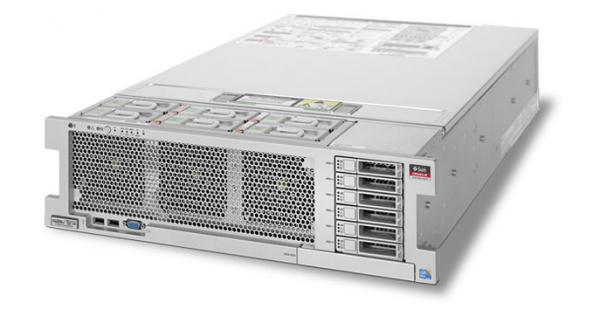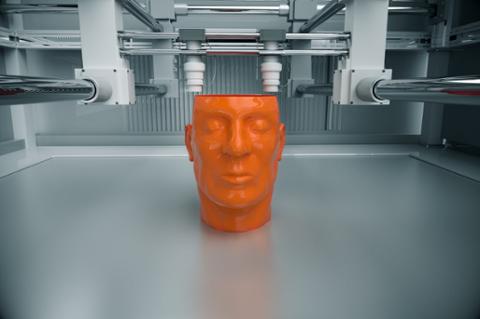 Oracle's analytics in a box.[/caption] Oracle just can’t quit hardware—at least, not yet. This week, Oracle announced a new release of its Oracle Exalytics In-Memory Machine X3-4, with a variety of hardware and software updates. The system comes packed with 2 TB of main memory along with 2.4 TB of flash storage and a 5.4 TB hard disk, strengthening its ability to analyze large datasets. Software includes Oracle Business Intelligence Foundation Suite 11.1.1.7, Oracle Endeca Information Discovery 3.0, and Oracle Hyperion Enterprise Performance Management (EPM) System Release 11.1.2.3. That’s a lot of hardware and software your average business needs to run a healthy analytics program—the platform can manage queries from Apache Hadoop, the popular framework, and a variety of data warehouses—but it also speaks to Oracle’s current dilemma: in a time when more and more IT vendors are gravitating toward the cloud as a way to deliver analytics software, Oracle is tied in many ways to its legacy hardware business, which is already dragging on the company’s bottom line. Oracle recently announced strategic partnerships with Microsoft and Salesforce that could increase its cloud reach. Salesforce will apparently standardize on the Oracle Linux operating system, Oracle Database and Java Middleware Platform, while Oracle will include Salesforce’s cloud-software offerings in the Oracle Fusion HCM and Financial Cloud; Oracle products will also be available via Microsoft’s cloud services. Other partnerships are probably forthcoming in the future; establishing cooperative relationships with other firms is perhaps Oracle’s best way to quickly bulk out its cloud offerings. It’s also a sea change from Oracle’s old strategy, in which it focused on its legacy business of selling integrated software and hardware stacks. With its rivals earning lots of cash and market-share from their own cloud offerings, Oracle clearly saw it was time to embrace the future—but such a shift is much easier said than done. As much as Oracle might want to embrace the cloud, it will need to push legacy hardware to customers for quite some time to come. Image: Oracle
Oracle's analytics in a box.[/caption] Oracle just can’t quit hardware—at least, not yet. This week, Oracle announced a new release of its Oracle Exalytics In-Memory Machine X3-4, with a variety of hardware and software updates. The system comes packed with 2 TB of main memory along with 2.4 TB of flash storage and a 5.4 TB hard disk, strengthening its ability to analyze large datasets. Software includes Oracle Business Intelligence Foundation Suite 11.1.1.7, Oracle Endeca Information Discovery 3.0, and Oracle Hyperion Enterprise Performance Management (EPM) System Release 11.1.2.3. That’s a lot of hardware and software your average business needs to run a healthy analytics program—the platform can manage queries from Apache Hadoop, the popular framework, and a variety of data warehouses—but it also speaks to Oracle’s current dilemma: in a time when more and more IT vendors are gravitating toward the cloud as a way to deliver analytics software, Oracle is tied in many ways to its legacy hardware business, which is already dragging on the company’s bottom line. Oracle recently announced strategic partnerships with Microsoft and Salesforce that could increase its cloud reach. Salesforce will apparently standardize on the Oracle Linux operating system, Oracle Database and Java Middleware Platform, while Oracle will include Salesforce’s cloud-software offerings in the Oracle Fusion HCM and Financial Cloud; Oracle products will also be available via Microsoft’s cloud services. Other partnerships are probably forthcoming in the future; establishing cooperative relationships with other firms is perhaps Oracle’s best way to quickly bulk out its cloud offerings. It’s also a sea change from Oracle’s old strategy, in which it focused on its legacy business of selling integrated software and hardware stacks. With its rivals earning lots of cash and market-share from their own cloud offerings, Oracle clearly saw it was time to embrace the future—but such a shift is much easier said than done. As much as Oracle might want to embrace the cloud, it will need to push legacy hardware to customers for quite some time to come. Image: Oracle Oracle’s Exalytics Release Hints at Continuing Hardware Dilemma
[caption id="attachment_11028" align="aligncenter" width="600"]  Oracle's analytics in a box.[/caption] Oracle just can’t quit hardware—at least, not yet. This week, Oracle announced a new release of its Oracle Exalytics In-Memory Machine X3-4, with a variety of hardware and software updates. The system comes packed with 2 TB of main memory along with 2.4 TB of flash storage and a 5.4 TB hard disk, strengthening its ability to analyze large datasets. Software includes Oracle Business Intelligence Foundation Suite 11.1.1.7, Oracle Endeca Information Discovery 3.0, and Oracle Hyperion Enterprise Performance Management (EPM) System Release 11.1.2.3. That’s a lot of hardware and software your average business needs to run a healthy analytics program—the platform can manage queries from Apache Hadoop, the popular framework, and a variety of data warehouses—but it also speaks to Oracle’s current dilemma: in a time when more and more IT vendors are gravitating toward the cloud as a way to deliver analytics software, Oracle is tied in many ways to its legacy hardware business, which is already dragging on the company’s bottom line. Oracle recently announced strategic partnerships with Microsoft and Salesforce that could increase its cloud reach. Salesforce will apparently standardize on the Oracle Linux operating system, Oracle Database and Java Middleware Platform, while Oracle will include Salesforce’s cloud-software offerings in the Oracle Fusion HCM and Financial Cloud; Oracle products will also be available via Microsoft’s cloud services. Other partnerships are probably forthcoming in the future; establishing cooperative relationships with other firms is perhaps Oracle’s best way to quickly bulk out its cloud offerings. It’s also a sea change from Oracle’s old strategy, in which it focused on its legacy business of selling integrated software and hardware stacks. With its rivals earning lots of cash and market-share from their own cloud offerings, Oracle clearly saw it was time to embrace the future—but such a shift is much easier said than done. As much as Oracle might want to embrace the cloud, it will need to push legacy hardware to customers for quite some time to come. Image: Oracle
Oracle's analytics in a box.[/caption] Oracle just can’t quit hardware—at least, not yet. This week, Oracle announced a new release of its Oracle Exalytics In-Memory Machine X3-4, with a variety of hardware and software updates. The system comes packed with 2 TB of main memory along with 2.4 TB of flash storage and a 5.4 TB hard disk, strengthening its ability to analyze large datasets. Software includes Oracle Business Intelligence Foundation Suite 11.1.1.7, Oracle Endeca Information Discovery 3.0, and Oracle Hyperion Enterprise Performance Management (EPM) System Release 11.1.2.3. That’s a lot of hardware and software your average business needs to run a healthy analytics program—the platform can manage queries from Apache Hadoop, the popular framework, and a variety of data warehouses—but it also speaks to Oracle’s current dilemma: in a time when more and more IT vendors are gravitating toward the cloud as a way to deliver analytics software, Oracle is tied in many ways to its legacy hardware business, which is already dragging on the company’s bottom line. Oracle recently announced strategic partnerships with Microsoft and Salesforce that could increase its cloud reach. Salesforce will apparently standardize on the Oracle Linux operating system, Oracle Database and Java Middleware Platform, while Oracle will include Salesforce’s cloud-software offerings in the Oracle Fusion HCM and Financial Cloud; Oracle products will also be available via Microsoft’s cloud services. Other partnerships are probably forthcoming in the future; establishing cooperative relationships with other firms is perhaps Oracle’s best way to quickly bulk out its cloud offerings. It’s also a sea change from Oracle’s old strategy, in which it focused on its legacy business of selling integrated software and hardware stacks. With its rivals earning lots of cash and market-share from their own cloud offerings, Oracle clearly saw it was time to embrace the future—but such a shift is much easier said than done. As much as Oracle might want to embrace the cloud, it will need to push legacy hardware to customers for quite some time to come. Image: Oracle
 Oracle's analytics in a box.[/caption] Oracle just can’t quit hardware—at least, not yet. This week, Oracle announced a new release of its Oracle Exalytics In-Memory Machine X3-4, with a variety of hardware and software updates. The system comes packed with 2 TB of main memory along with 2.4 TB of flash storage and a 5.4 TB hard disk, strengthening its ability to analyze large datasets. Software includes Oracle Business Intelligence Foundation Suite 11.1.1.7, Oracle Endeca Information Discovery 3.0, and Oracle Hyperion Enterprise Performance Management (EPM) System Release 11.1.2.3. That’s a lot of hardware and software your average business needs to run a healthy analytics program—the platform can manage queries from Apache Hadoop, the popular framework, and a variety of data warehouses—but it also speaks to Oracle’s current dilemma: in a time when more and more IT vendors are gravitating toward the cloud as a way to deliver analytics software, Oracle is tied in many ways to its legacy hardware business, which is already dragging on the company’s bottom line. Oracle recently announced strategic partnerships with Microsoft and Salesforce that could increase its cloud reach. Salesforce will apparently standardize on the Oracle Linux operating system, Oracle Database and Java Middleware Platform, while Oracle will include Salesforce’s cloud-software offerings in the Oracle Fusion HCM and Financial Cloud; Oracle products will also be available via Microsoft’s cloud services. Other partnerships are probably forthcoming in the future; establishing cooperative relationships with other firms is perhaps Oracle’s best way to quickly bulk out its cloud offerings. It’s also a sea change from Oracle’s old strategy, in which it focused on its legacy business of selling integrated software and hardware stacks. With its rivals earning lots of cash and market-share from their own cloud offerings, Oracle clearly saw it was time to embrace the future—but such a shift is much easier said than done. As much as Oracle might want to embrace the cloud, it will need to push legacy hardware to customers for quite some time to come. Image: Oracle
Oracle's analytics in a box.[/caption] Oracle just can’t quit hardware—at least, not yet. This week, Oracle announced a new release of its Oracle Exalytics In-Memory Machine X3-4, with a variety of hardware and software updates. The system comes packed with 2 TB of main memory along with 2.4 TB of flash storage and a 5.4 TB hard disk, strengthening its ability to analyze large datasets. Software includes Oracle Business Intelligence Foundation Suite 11.1.1.7, Oracle Endeca Information Discovery 3.0, and Oracle Hyperion Enterprise Performance Management (EPM) System Release 11.1.2.3. That’s a lot of hardware and software your average business needs to run a healthy analytics program—the platform can manage queries from Apache Hadoop, the popular framework, and a variety of data warehouses—but it also speaks to Oracle’s current dilemma: in a time when more and more IT vendors are gravitating toward the cloud as a way to deliver analytics software, Oracle is tied in many ways to its legacy hardware business, which is already dragging on the company’s bottom line. Oracle recently announced strategic partnerships with Microsoft and Salesforce that could increase its cloud reach. Salesforce will apparently standardize on the Oracle Linux operating system, Oracle Database and Java Middleware Platform, while Oracle will include Salesforce’s cloud-software offerings in the Oracle Fusion HCM and Financial Cloud; Oracle products will also be available via Microsoft’s cloud services. Other partnerships are probably forthcoming in the future; establishing cooperative relationships with other firms is perhaps Oracle’s best way to quickly bulk out its cloud offerings. It’s also a sea change from Oracle’s old strategy, in which it focused on its legacy business of selling integrated software and hardware stacks. With its rivals earning lots of cash and market-share from their own cloud offerings, Oracle clearly saw it was time to embrace the future—but such a shift is much easier said than done. As much as Oracle might want to embrace the cloud, it will need to push legacy hardware to customers for quite some time to come. Image: Oracle 
